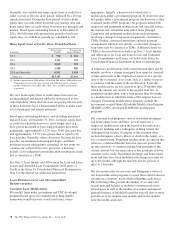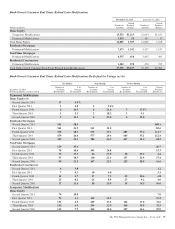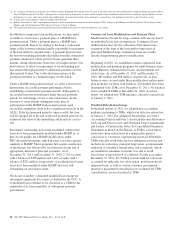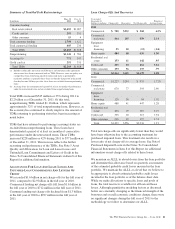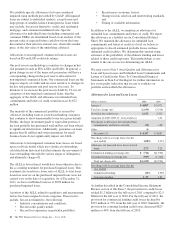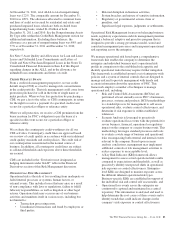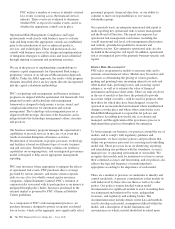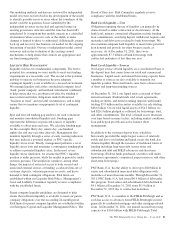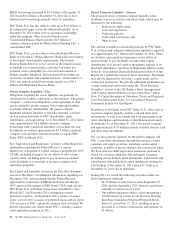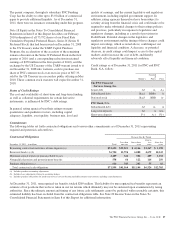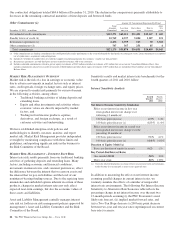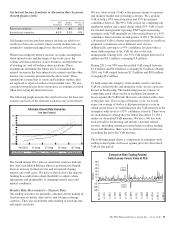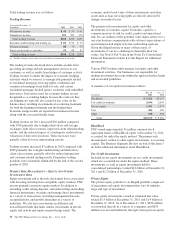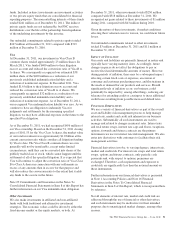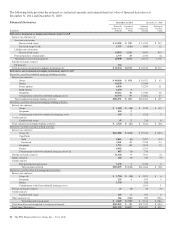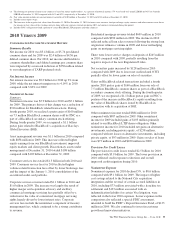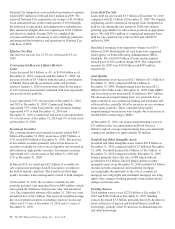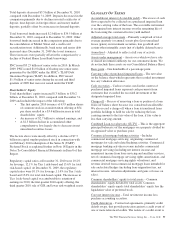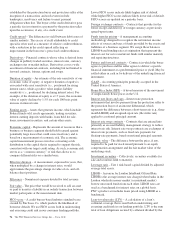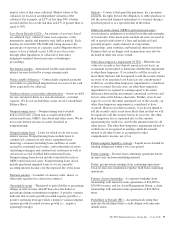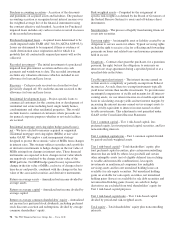PNC Bank 2011 Annual Report Download - page 97
Download and view the complete annual report
Please find page 97 of the 2011 PNC Bank annual report below. You can navigate through the pages in the report by either clicking on the pages listed below, or by using the keyword search tool below to find specific information within the annual report.
Our contractual obligations totaled $84.6 billion at December 31, 2010. The decline in the comparison is primarily attributable to
decreases in the remaining contractual maturities of time deposits and borrowed funds.
Other Commitments (a) Amount Of Commitment Expiration By Period
December 31, 2011 – in millions
Total
Amounts
Committed
Less than
one year
One to three
years
Four to
five years
After
five
years
Net unfunded credit commitments $103,271 $48,011 $31,491 $23,167 $ 602
Standby letters of credit (b) 10,769 4,537 5,004 1,107 121
Reinsurance agreements (c) 6,432 2,959 105 50 3,318
Other commitments (d) 707 367 251 85 4
Total commitments $121,179 $55,874 $36,851 $24,409 $4,045
(a) Other commitments are funding commitments that could potentially require performance in the event of demands by third parties or contingent events. Loan commitments are reported
net of syndications, assignments and participations.
(b) Includes $7.4 billion of standby letters of credit that support remarketing programs for customers’ variable rate demand notes.
(c) Reinsurance agreements are with third-party insurers related to insurance sold to our customers.
(d) Includes unfunded commitments related to private equity investments of $247 million and other investments of $3 million that are not on our Consolidated Balance Sheet. Also
includes commitments related to tax credit investments of $420 million and other direct equity investments of $37 million that are included in Other liabilities on our Consolidated
Balance Sheet.
M
ARKET
R
ISK
M
ANAGEMENT
O
VERVIEW
Market risk is the risk of a loss in earnings or economic value
due to adverse movements in market factors such as interest
rates, credit spreads, foreign exchange rates, and equity prices.
We are exposed to market risk primarily by our involvement
in the following activities, among others:
• Traditional banking activities of taking deposits and
extending loans,
• Equity and other investments and activities whose
economic values are directly impacted by market
factors, and
• Trading in fixed income products, equities,
derivatives, and foreign exchange, as a result of
customer activities and underwriting.
We have established enterprise-wide policies and
methodologies to identify, measure, monitor, and report
market risk. Market Risk Management provides independent
oversight by monitoring compliance with these limits and
guidelines, and reporting significant risks in the business to
the Risk Committee of the Board.
M
ARKET
R
ISK
M
ANAGEMENT
–I
NTEREST
R
ATE
R
ISK
Interest rate risk results primarily from our traditional banking
activities of gathering deposits and extending loans. Many
factors, including economic and financial conditions,
movements in interest rates, and consumer preferences, affect
the difference between the interest that we earn on assets and
the interest that we pay on liabilities and the level of our
noninterest-bearing funding sources. Due to the repricing term
mismatches and embedded options inherent in certain of these
products, changes in market interest rates not only affect
expected near-term earnings, but also the economic values of
these assets and liabilities.
Asset and Liability Management centrally manages interest
rate risk set forth in our risk management policies approved by
management’s Asset and Liability Committee and the Risk
Committee of the Board.
Sensitivity results and market interest rate benchmarks for the
fourth quarters of 2011 and 2010 follow:
Interest Sensitivity Analysis
Fourth
Quarter
2011
Fourth
Quarter
2010
Net Interest Income Sensitivity Simulation
Effect on net interest income in first year
from gradual interest rate change over
following 12 months of:
100 basis point increase 2.3% 1.4%
100 basis point decrease (a) (1.5)% (1.4)%
Effect on net interest income in second year
from gradual interest rate change over the
preceding 12 months of:
100 basis point increase 7.1% 4.1%
100 basis point decrease (a) (4.4)% (4.8)%
Duration of Equity Model (a)
Base case duration of equity (in years): (6.2) (.5)
Key Period-End Interest Rates
One-month LIBOR .30% .26%
Three-year swap .82% 1.28%
(a) Given the inherent limitations in certain of these measurement tools and techniques,
results become less meaningful as interest rates approach zero.
In addition to measuring the effect on net interest income
assuming parallel changes in current interest rates, we
routinely simulate the effects of a number of nonparallel
interest rate environments. The following Net Interest Income
Sensitivity to Alternative Rate Scenarios table reflects the
percentage change in net interest income over the next two
12-month periods assuming (i) the PNC Economist’s most
likely rate forecast, (ii) implied market forward rates, and
(iii) a Two-Ten Slope decrease (a 200 basis point decrease
between two-year and ten-year rates superimposed on current
base rates) scenario.
88 The PNC Financial Services Group, Inc. – Form 10-K


